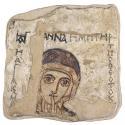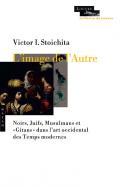Art Of The Day Weekly
#362 - from 30 October 2014 to 5 November 2014
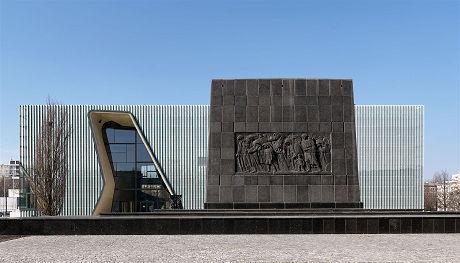
Polin Museum of the History of Polish Jews, Warsaw. Photo Wojciech Kryoski.
IN THE AIR
Letter from Warsaw: a Jewish memory
Nearly 3.3 million in 1939, maybe 15,000 persons today. The Jewish population in Poland dramatically decreased and the Shoah is obviously responsible for this. While there already was a museum dedicated to the Warsaw uprising, there was a great need for a general view of the Jewish presence, that marked ten centuries of the country's history, since the 11th century (according to the legend, the Jews who were persecuted in Germany found refuge in the mythical forest of Polin, where the barks of the trees bore the verses of the Talmud), up to the latest wave of emigration in 1967-68. Now this vaccum has been filled with this glass museum, symbolically fractured down its middle, designed by Finnish architects Lahdelma & Mahlamäki. The museum holds a few pieces such as paintings, religious objects, and even some food ration tickets. But, based mainly on references -photographs, movies, models - and reconstitutions such as that of a shtetl or the synagogue of Gwozdiec with its superb mural paintings, it covers an extremely rich history. There are golden ages under Casimir the Great for example in the 14th century, and persecutions - even in 1946, the residents of Kielce accused the Jews of a ritual murder on a Christian child. The quantity of information can be disconcerting but it meets the wishes of the designers: while we know how the Jews of Poland died, we know a lot less about how they lived. A way of partially renewing with the thread of memory.
• The Polin museum of the History of the Jews in Poland was inaugurated on 28 October 2014.
ALSO TO SEE IN POLAND
Wonders from Nubia
WARSAW - On the eve of the construction of the Pharaonic Aswan dam, archaeological diggings were launched to save the riches along the Nile. The Polish archaeologists, who were working in Sudan, to the South of the first waterfall, directed by Kazimierz Michalowski (1901-1981), unearthed in Faras a cathedral built in the 7th century, and constantly enriched up to the 14th century. Through an agreement with the Sudanese government, half of the findings were sent to the National Museum of Warsaw. Textiles, funeral monuments, sculpted capitals and above all some sixty frescoes (the Holy Family, the archangels and saints) that reperesent the most beautiful fund of Nubian art in Europe. It has been completely rearranged in a new museography which incorporates other pieces that come from the Christian kingdoms of Ethiopia.
• The Faras gallery at the National Museum opened to the public on 13 October 2014.
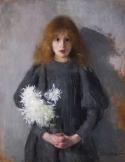
Olga Boznanska, La Jeune fille aux chrysanthèmes, oil on canvas, Krakow National Museum (restored with the help of Fondation Paribas).
Boznanska, a Pole in Paris
KRAKOW – She is one of the most renowned modern artists of the county. Born in 1865 in Krakow from a French mother, partly educated in Munich, Olga Boznanska settled in Paris at the end of the XIXth century. She was to become a sought-after portrait artist until her death in 1940. The Krakow National Museum received the donation of the contents of her Paris atelier and has confronted 170 of her paintings to the works of some of her contemporaries. The exhibition draws the image of a refined society of the Belle Epoque through her portraits - done in light and hazzy touches - of painters and writers, mondane and elegant ladies.
• Olga Boznanska at the National Museum of Krakow, from 25 October 2014 to 1 February 2015.
EXHIBITIONS: FOCUS ON WORLD WAR I
Memories of Van Eyck
BERLIN – It is the most famous work by the Van Eyck brothers, which is currently being restored at the museum of Ghent. The polyptych altarpiece of the Adoration of the Mystic Lamb is present here by proxy, recreated based on copies of the 16th and 17th centuries and on photographs. This is one way of reminding all that the work was once the property of the museum, and that it was only returned to Belgium in 1920, as part of an agreement of war reparations.
• The Ghent Altarpiece by the Van Eyck brothers at the Gemaldegälerie, from 4 September 2014 to 29 March 2015.
Feeling the war
BERLIN – It is impossible to remain indifferent in front of war. But how does one react according to one’s time? The exhibition looks precisely at how human beings act or react, both through souvenirs from World War I and creations by contemporary artists such as Gunther Uecker.
• Feeling War at the Museum Europäischer Kulturen, from 27 June 2014 to 28 June 2015
WWI, one century later
PARIS – How can we speak about World War I a century after it occurred? This challenge is met by certain contemporary photographers who have various « strategies » to refer to this past event. They (Bréson for example) scrutinize the landscape in search of traces of the conflagration – some of them are still perfectly visible. Others (like Bard) explore the cemeteries and stained glass windows of churches, and discover the fine thread of these lives that were taken. Lastly, others like Ventura or Fleisher with an installation of portraits of the of the dead floating in a revealing bath, believe that fiction can say as much as reality and they rebuild certain scenes, referring to atmospheres. These are all means of setting the memory which is altered and nourished by the passage of time.
• Mémoire traversée, paysage, visage de la Grande Guerre at Eléphant Paname, from 31 October 2014 to 18 January 2015.
The Italy that was
ROME – What did the art developed in Italy at the eve of World War I look like? In 1905, Boccioni and Severini organised a fair for the rejected artists, to go against the academic art and its intention was to absorb the influences of the German avant-garde movements. When war was declared in 1915, the Futurists signed up with passion, while other such as De Chirico or Carrà perfected their means to elaborate an art of silence and disenchantment.
• Secessione e Avanguardia at the GNAM, from 31 October 2014 to 15 February 2015.
Venice on the watch
VENICE – In 1915, a year after its allies, Italy entered the war against Germany. Venice, being very close to the Austrian border, protected itself. The construction sites aimed at protecting men and the heritage of the Serenissima are unveiled to us through 350 documents, photos and stamps of the time. Military exercices on the traditional wood terraces (altane), sand bags stacked in front of the churches and basilicas, the statue of Colleoni (by Verrocchio) moved away or the frescoes by Tintoretto at the Scuola Grande di San Rocco: all these efforts were justified by shelling at the beginning of 1918- of which 300 bombs during the night of 27 February alone.
• Venezia si difende at the Casa dei Tre Oci, from 13 September to 8 December 2014.
AUCTIONS
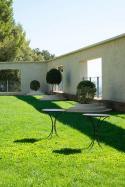
Lot 63 - Jean-Michel Frank and Adolphe Chanaux, a pair of round-shaped guéridons, circa 1935. 64x51 cm. Provenance : Carlos Maria Alvear, Palais Sans-Souci, Buenos Aires. Estimate: €20,000-30,000.
Art deco: the road to Buenos Aires
HYÈRES - The Noailles family is constantly in the limelight, even indirectly. Following the issue of Sade’s scroll of 120 Days of Sodoma (which was theirs and is now exhibited at the musée des Lettres et Manuscrits), and while the beautiful Baccarat retrospective is held at the Petit Palais (their apartment on place des Etats-Unis, redecorated by Philippe Starck, is the showroom of the brand), it is their villa at Hyères (designed by Mallet-Stevens) that will occupy the front line. Indeed it has been chosen as the setting for an Art Deco auction based on an unbeatable argument: these pieces of furniture could have furnished it at the turn of the 1920s and 1930s when the daily visitors included Man Ray and Buñuel, Cocteau and Lifar. The lots include include pieces by Dupré-Lafon or André Groult, lamps by Perzel or Boris Lacroix, sculptures by the Martel twins. The most spectacular lot comes from Buenos Aires, from the former Lectoure collection, and from the Palais Sans-Souci, built in 1916 by architect René Sargent for the Alvear family. The palace has been the property of the Durini, a family of Italian aristocrats, for the last 50 years. Today it reveals a few gems by Jean-Michel Frank – brass pedestal tables, tables in shagreen. It is only fair that a part of the profits of the sale should be handed over to villa Noailles to finance their acquisitions and activities.
• Art déco at Villa Noailles (sale organised by SVV Damien Leclère, Marseille), on 5 November 2014.
BOOKS
Portrait of the foreigner
In a time of crisis, the “Other” is often accused of all the ills. How can we define him though? This book which accompanied a cycle of conferences given at the Louvre in September and October 2014, shows how the major figures that act as a foil were created in Western art over the last centuries: those are the black man, the Jew, the Muslim or the Gypsy. The author (an expert in ‘otherness’ given he was born in Bucharest, educated in Rome and Paris, and teaches in Friburg) studied the way painters such as Bosch, Caravaggio or Rubens represented them, and he dissects the least detail. The physical traits, any distinctive signs and ways of representation are little by little codified by the painters. The Jew for example is characterised by his yellow clothes, the colour Judas wore in Giotto’s frescoes in the Scrovegni chapel in Padova ; and also by the mandatory yellow cloth circle, and if possible by a portrait in profile, to insist on the hooked nose, the receding forehead and the red hair. The same applies to the Muslim with his turban or the Gypsy with his gimmicked cards: the clichés that nourished racist propaganda go quite far back.
• L’image de l’Autre. Noirs, Juifs, Musulmans et « Gitans » dans l’art occidental des Temps modernes, by Victor Stoichita, Hazan, 2014, 280 p., €25.
IN BRIEF
GENEVA - The new Museum of Ethnography will open to the public on 31 October 2014.
PARIS - Julien Prévieux has been awarded the 2014 Marcel Duchamp contemporary art prize.
PARIS – The 65th edition of the exhibition of contemporary art, Jeune Création, will be held at the 104, from 30 October to 2 November 2014.

